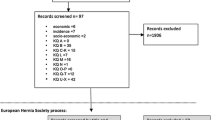Abstract
Purpose
Seroma is a frequent postoperative complication after laparoscopic direct inguinal hernia repair (both in TAPP and TEP). There are several methods to address this problem; however, these techniques are not without problems. The purpose of this study was to introduce and evaluate a new technique to address this problem.
Methods
This is a prospective study of consecutive patients. All patients diagnosed with direct inguinal hernias eligible for laparoscopic repair were included. A single surgeon performed all the included operations. During laparoscopic inguinal hernia repair (TAPP or TEP), we closed the direct hernia defect with barbed sutures around the transversalis fascia, inverted the apex of the attenuated transversalis fascia, and sutured it at the base to completely eradicate the defect cavity. Prosthetic mesh was not additionally fixed in all patients. The primary postoperative outcome parameter was seroma formation, and secondary outcome parameters included groin pain, surgical complications, and hernia recurrence.
Results
Twenty-five male patients with 36 sides of direct hernias were included in this study, and all procedures were carried out laparoscopically and successfully. Only one patient developed significant seroma, which resolved 1 month later. The early postoperative pain was minimal, and no recurrence and chronic pain occurred during the follow-up period (4–13 months).
Conclusions
The present direct inguinal hernia defect closing technique with barbed suture is a simple, easily reproducible, and effective method for the prevention of seroma formation.




Similar content being viewed by others
References
Schmedt CG, Sauerland S, Bittner R (2005) Comparison of endoscopic procedures vs. Lichtenstein and other open mesh techniques for inguinal hernia repair. Surg Endosc 19:188–199
Mahon D, Decadt B, Rhodes M (2003) Prospective randomized trial of laparoscopic (transabdominal preperitoneal) vs. open (mesh) repair for bilateral and recurrent inguinal hernia. Surg Endosc 17(9):1386–1390
Lau H, Lee F (2003) Seroma following endoscopic extraperitoneal inguinal hernioplasty. Surg Endosc 17:1773–1777
Simons MP, Aufenacker T, Bay-Nielsen M, Bouillot JL, Campanelli G, Conze J, de Lange D, Fortelny R, Heikkinen T, Kingsnorth A, Kukleta J, Morales-Conde S, Nordin P, Schumpelick V, Smedberg S, Smietanski M, Weber G, Miserez M (2009) European Hernia Society guidelines on the treatment of inguinal hernia in adult patients. Hernia 13:343–403
Bittner R, Schwarz J (2012) Inguinal hernia repair: current surgical techniques. Langenbecks Arch Surg 397:271–282
Schwab R, Willms A, Kröger A, Becker HP (2006) Less chronic pain following mesh fixation using a Wbrin sealant in TEP inguinal hernia repair. Hernia 10:272–277
Topart P, Vandenbroucke F, Lozac’h P (2005) Tisseel versus tack staples as mesh fixation in totally extraperitoneal laparoscopic repair of groin hernias: a retrospective analysis. Surg Endosc 19:724–727
Lovisetto F, Zonta S, Rota E, Bottero L, Faillace G, Turra G, Fantini A, Longoni M (2007) Laparoscopic transabdominal preperitoneal (TAPP) hernia repair: surgical phases and complications. Surg Endosc 21:646–652
Lau H (2005) Fibrin sealant versus mechanical stapling for mesh fixation during endoscopic extraperitoneal inguinal hernioplasty: a randomized prospective trial. Ann Surg 242:670–675
Boldo E, Armelles A, Perez de Lucia G, Martin F, Aracil JP, Miralles JM, Martinez D, Escrig J (2008) Pain after laparoscopic bilateral hernioplasty: early results of a prospective randomized double-blind study comparing fibrin versus staples. Surg Endosc 22:1206–1209
Ismail M, Garg M, Rajagopal M, Garg P (2009) Impact of closed-suction drain in preperitoneal space on the incidence of seroma formation after laparoscopic total extraperitoneal inguinal hernia repair. Surg Laparosc Endosc Percutan Tech 19:263–266
Shpitz B, Kuriansky J, Werener M, Osadchi A, Tiomkin V, Bugayev N, Klein E (2004) Early postoperative evaluation of groins after laparoscopic total extraperitoneal repair of inguinal hernias. J Laparoendosc Adv Surg Tech A 14:353–357
Reddy VM, Sutton CD, Bloxham L, Garcea G, Ubhi SS, Robertson GS (2007) Laparoscopic repair of direct inguinal hernia: a new technique that reduces the development of postoperative seroma. Hernia 11:393–396
Shinde PT (2009) Fibrin sealant versus use of tackers for fixation of mesh in laparoscopic inguinal hernia repair. World J Laparosc Surg 2:42–48
Berney CR (2012) The Endoloop technique for the primary closure of direct inguinal hernia defect during the endoscopic totally extraperitoneal approach. Hernia 16:301–305. doi:10.1007/s10029-011-0892-z Epub 2011 Nov 27
Silvestre AC, Mathia GBD, Fagybdes DJ, Medeiros LR, Rosa MI (2011) Shrinkage evaluation of heavyweight and lightweight polypropylene meshes in inguinal hernia repair: a randomized controlled trial. Hernia 15:629–634
Orenstein SB, Dumeer JL, Monteagudo J, Poi MJ, Novitsky YW (2011) Outcomes of laparoscopic ventral hernia repair with routine defect closure using “Shoelace” technique. Surg Endosc 25:1452–1457
Shestak KC, Edington HJ, Johnson RR (2000) The separation of anatomic components technique for the reconstruction of massive midline abdominal wall defects: anatomy, surgical technique, applications, and limitations revisited. Plast Reconstr Surg. 105:731–738
Author information
Authors and Affiliations
Corresponding author
Ethics declarations
Disclosures
Junsheng Li and Weiyu Zhang have no conflicts of interest or financial ties to disclose.
Electronic supplementary material
Below is the link to the electronic supplementary material.
Rights and permissions
About this article
Cite this article
Li, J., Zhang, W. Closure of a direct inguinal hernia defect in laparoscopic repair with barbed suture: a simple method to prevent seroma formation?. Surg Endosc 32, 1082–1086 (2018). https://doi.org/10.1007/s00464-017-5760-1
Received:
Accepted:
Published:
Issue Date:
DOI: https://doi.org/10.1007/s00464-017-5760-1




